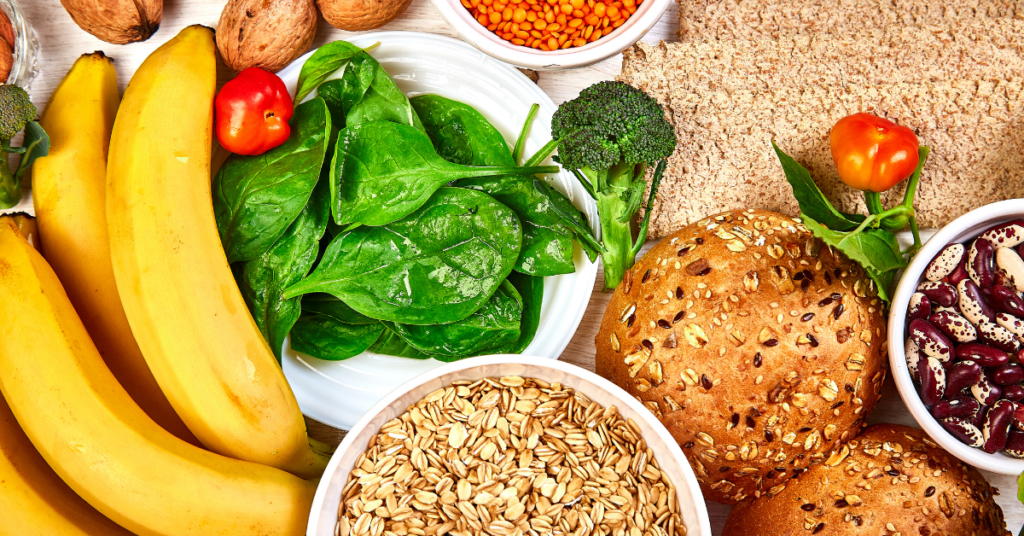At one time fibre was thought to serve no useful purpose in the body, as it does not contain any nutrients. A dietitian friend told me she was taught during her training that the idea that wholemeal bread was better for you in some way than white bread was ridiculed.
But no longer. We now know that fibre performs some very important functions in our diet to maintain our good health.
The NHS website says:
“Most of us need to eat more fibre and have fewer added sugars in our diet. Eating plenty of fibre is associated with a lower risk of heart disease, stroke, type 2 diabetes and bowel cancer.”
Harvard Health says:
“To reduce your risk of getting diverticulitis, you should try and add high-fiber foods to each meal. Aim for up to half your plate to contain some fiber-rich food. via How to get more fiber in your diet”-
What does dietary fibre do to my body?
Ok, so it’s important, but it doesn’t contain protein or vitamins or minerals, so what exactly does it do? In fact dietary fibre has many benefits including:
- Making your stools (your poo) bulkier and softer, so they are easier to pass. You are much less likely to suffer from constipation if you have enough fibre in your diet.
- If your stools are loose and watery, the fibre can help by absorbing the excess water, giving you more control.
- Fibre keeps the intestinal wall clean and reduces the likelihood of developing diverticulitis.
- Bacteria in the colon can break down fibre, creating an acidic environment that decreases the risk of developing colorectal cancer.
- A high fibre intake can increase the beneficial bacteria population.
- Foods high in fibre can take longer to eat, increasing the feeling of fullness after a meal, and so help weight control.
- Food high in fibre is digested more slowly and so glucose may be released more slowly into the blood stream.
- Dietary fibre can reduce your risk of cardiovascular disease (heart disease and stroke) and type 2 diabetes.
- Foods such as oats and barley contain a type of fibre known as beta glucan, which may help to reduce cholesterol levels if you consume 3g or more of it daily, as part of a healthy diet.
- Researchers found that higher levels of dietary fibre are associated with a reduced risk of developing dementia. In a large-scale study, over 3500 Japanese adults completed a dietary survey and were then followed up for two decades. Adults who consumed more fiber, particularly soluble fiber, were less likely to go on to develop dementia.
A 2021 study published in the Journal of Nutrition by researchers at the Jean Mayer USDA Human Nutrition Research Center on Aging at Tufts University examined how whole- and refined-grain intake over time impacted five risk factors of heart disease: waist size, blood pressure, blood sugar, triglyceride, and HDL (“good”) cholesterol.
The results showed that for each four-year interval:
- Waist size increased by an average of over 1 inch in the low intake participants, versus about ½ inch in the high intake participants.
- Even after accounting for changes in waist size, average increases in blood sugar levels and systolic blood pressure were greater in low intake participants compared to high intake participants.
One of the researchers Nicola McKeown senior and corresponding author and a scientist on the Nutritional Epidemiology Team at the USDA HNRCA) said:
“The average American consumes about five servings of refined grains daily, much more than is recommended, so it’s important to think about ways to replace refined grains with whole grains throughout your day. For example, you might consider a bowl of whole-grain cereal instead of a white flour bagel for breakfast and replacing refined-grain snacks, entrees, and side dishes with whole-grain options. Small incremental changes in your diet to increase whole-grain intake will make a difference over time,”
What is soluble fibre?
The British Nutrition Foundation says this:
“You may have heard of the terms ‘soluble fibre’ or ‘insoluble fibre’– these are words that are sometimes used to describe the types of fibre in our diet. Although scientific organisations argue that these terms are no longer really appropriate, you may see these terms being used, with soluble fibre including pectins and beta glucans (found for example in foods like fruit and oats) and insoluble fibre including cellulose (found for example in wholegrains and nuts). What is important to remember is that fibre-rich foods typically contain both types of fibre.”
How do I know if I’m eating enough fibre?
Most people just aren’t eating enough fibre. The NHS website says:
“[UK] Government guidelines published in July 2015 say our dietary fibre intake should increase to 30g a day, as part of a healthy balanced diet. As most adults are only eating an average of about 18g day, we need to find ways of increasing our intake.”
How do I prevent gas from eating high fibre diet?
You may be concerned about gas if you increase your fibre intake. Producing a lot of gas can be embarrassing and painful. The gas occurs because bacteria within the colon produce gas as a by-product of their digestion of fibre. Harvard Health say:
“be careful about eating a lot of fiber at once. Overdoing it can cause gas, bloating, diarrhea, and abdominal cramps as your gut bacteria try to process all the new fiber. These problems go away after a while as your digestive system gets used to the higher fiber levels, but you can avoid them by adding extra fiber gradually to your diet. For example, try to add just one more serving of a high-fiber food to your daily diet for a week, then see how your body feels. Give yourself another week, if needed. If everything is okay, add another daily serving for a week. Continue this pattern until you reach your daily quota of fiber.
“Also, make sure to drink plenty of fluids each day—about 16 ounces of water, four times a day. Increasing the water you drink can help fiber pass through your digestive system and avoid stomach distress.”
Coral Sirett of Zest Health has written a very interesting article entitled 15 Ways With Pulses. She says:
“If you have been put off eating more beans because you’re concerned about wind [gas] my advice is to increase the amount you eat gradually. This will help your body to adjust to the increase in fibre.
“You can also make pulses more digestible by rinsing them if you buy canned.
“The easiest beans to digest are black-eyed peas, adzuki, lentils and mung beans. You may also find them easier to digest if you eat with another source of protein such as quinoa, rice or barley.”
Disadvantages Of fibre
Fibre can bind with some minerals such as iron and reduce their absorption. If you are taking an iron supplement, take it with something with vitamin C (e.g. orange juic) and keep it away from a high fibre meal.
If you already have diverticulitis, Crohn’s disease, irritable bowel syndrome, etc., you may not benefit from an increase in fibre, as this can physically aggravate the existing problems.
How can I increase my fibre intake?
The British Nutrition Foundation suggests:
- Choose a high fibre breakfast cereal e.g. wholegrain cereal like wholewheat biscuit cereal, no added sugar muesli, bran flakes or porridge. Why not add some fresh fruit, dried fruit, seeds and/or nuts.
- Go for wholemeal or seeded wholegrain breads. If your family only typically likes white bread, why not try the versions that combine white and wholemeal flours as a start.
- Choose wholegrains like wholewheat pasta, bulgur wheat or brown rice.
- Go for potatoes with skins e.g. baked potato, wedges or boiled new potatoes – you can eat these hot or use for a salad.
- For snacks try fruit, vegetable sticks, rye crackers, oatcakes, unsalted nuts or seeds.
- Include plenty of vegetables with meals – either as a side dish/salad or added to sauces, stews or curries – this is a good way of getting children to eat more veg.
- Keep a supply of frozen vegetables so you are never without.
- Add pulses like beans, lentils or chickpeas to stews, curries and salads.
- Have some fresh or fruit canned in natural juice for dessert or a snack.
Coral Sirett has some good suggestions in her article 15 Ways With Pulses for what you can make with pulses.
If you’re eating a plant-based diet, you will naturally be eating plenty of fibre and repeaing all the benefits that gives.


